Choosing the right hiking boots is a matchmaking process. Your dream hiking boots need to sync with how and where you hike. Before you tie the knot, though, you also have to be sure they're a perfect fit.
- Types: You have a dizzying array of choices, from ultralight trail shoes to mountaineering boots.
- Components: Understanding a little more about what goes into uppers, lowers, midsoles, outsoles and other parts of a boot can help you refine your selection.
- Fit: No one ever loved a pair of ill-fitting boots. The difference between blisters and bliss is taking the time to get a great fit.
Ready to buy a new pair of boots? Check out our guide to the best hiking boots.
Video: Hiking Boot Basics
Types of Hiking Boots
Hiking shoes: Low-cut models with flexible midsoles are excellent for day hiking. Some ultralight backpackers may even choose trail-running shoes for long-distance journeys.
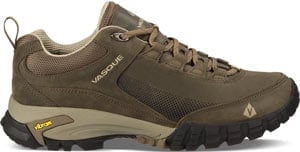
Day hiking boots: These range from mid- to high-cut models and are intended for day hikes or short backpacking trips with light loads. They often flex easily and require little break-in time, but they lack the support and durability of stout backpacking boots.
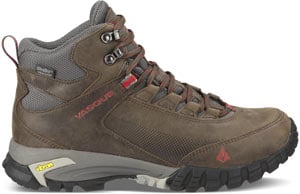
Backpacking boots: These are designed to carry heavier loads on multiday trips deep into the backcountry. Most have a high cut that wraps above the ankles for excellent support. Durable and supportive, with stiffer midsoles than lighter footwear, they are suitable for on- or off-trail travel.
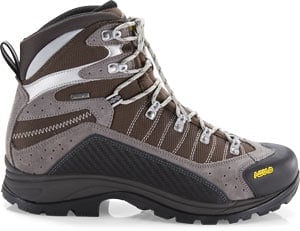
Hiking Boot Components

Hiking Boot Uppers
Materials impact a boot's weight, breathability, durability and water resistance.
- Full-grain leather: Full-grain leather offers excellent durability and abrasion resistance and very good water resistance. It's most commonly used in backpacking boots built for extended trips, heavy loads and rugged terrain. It is not as light or breathable as nylon/split-grain leather combinations. Ample break-in time is needed before starting an extended trip.
- Split-grain leather: Split-grain leather is usually paired with nylon or nylon mesh to create a lightweight boot that offers excellent breathability. Split-grain leather "splits away" the rougher inner part of the cowhide from the smooth exterior. The benefit is lower cost, however, the downside is less resistance to water and abrasion (though many feature waterproof liners).
- Nubuck leather: Nubuck leather is full-grain leather that has been buffed to resemble suede. It is very durable and resists water and abrasion. It's also fairly flexible, yet it too requires ample time to break in before an extended hike.
- Synthetics: Polyester, nylon and so-called "synthetic leather" are all commonly found in modern boots. They are lighter than leather, break in more quickly, dry faster and usually cost less. Downside: They may show wear sooner due to more stitching on the outside of the boot.
- Waterproof membranes: Boots and shoes billed as "waterproof" feature uppers constructed with waterproof/breathable membranes (such as Gore-Tex® or eVent®) to keep feet dry in wet conditions. Downside: The reduced breathability created by a membrane (compared to the ventilating mesh used on some nonwaterproof shoes) may encourage feet to sweat on summer days.
- Vegan: Vegan-friendly hiking boots and shoes are made without any animal ingredients or byproducts.
- Insulation: Synthetic insulation is added to some mountaineering boots for warmth when hiking on snow and glaciers.

Hiking Boot Midsoles
The midsole, which provides cushioning, buffers feet from shock and largely determines a boot's stiffness. Stiff boots might not sound like a good thing, but for long hikes on rocky, uneven terrain they can mean greater comfort and stability. A stiff boot won't allow your foot to wear out by wrapping around every rock or tree root you step on. The most common midsole materials are EVA (ethylene vinyl acetate) and polyurethane.
- EVA is a bit cushier, lighter and less expensive. Midsoles use varying densities of EVA to provide firmer support where needed (e.g., around the forefoot).
- Polyurethane is generally firmer and more durable, so it's usually found in extended backpacking and mountaineering boots.

Hiking Boot Internal Support
- Shanks: These 3-5mm thick inserts are sandwiched between a boot's midsole and outsole to add load-bearing stiffness to the midsole. They vary in length; some cover the entire length of the midsole, while others only cover half.
- Plates: These thin, semiflexible inserts are positioned between the midsole and the outsole, and below the shank (if included). They protect feet from getting bruised by roots or uneven rocks.
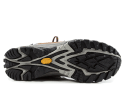
Hiking Boot Outsoles
Rubber is used on all hiking boot outsoles. Additives such as carbon are sometimes added to backpacking or mountaineering boots to boost hardness. Hard outsoles increase durability but can feel slick if go you off trail.
- Lug pattern: Lugs are traction-giving bumps on the outsole. Deeper, thicker lugs are used on backpacking and mountaineering boots to improve grip. Widely spaced lugs offer good traction and shed mud more easily.
- Heel brake: This refers to the clearly defined heel zone that is distinct from the forefoot and arch. It reduces your chance of sliding during steep descents.
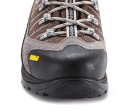
Crampon Compatibility
If you plan to do mountaineering or winter backpacking, having compatible boots and crampons is essential for your safety. When you shop on REI.com for men's mountaineering boots or women's mountaineering boots, narrow your search by crampon compatibility. To learn more about crampons, read our Crampons: How to Choose article.
Hiking Boot Fit
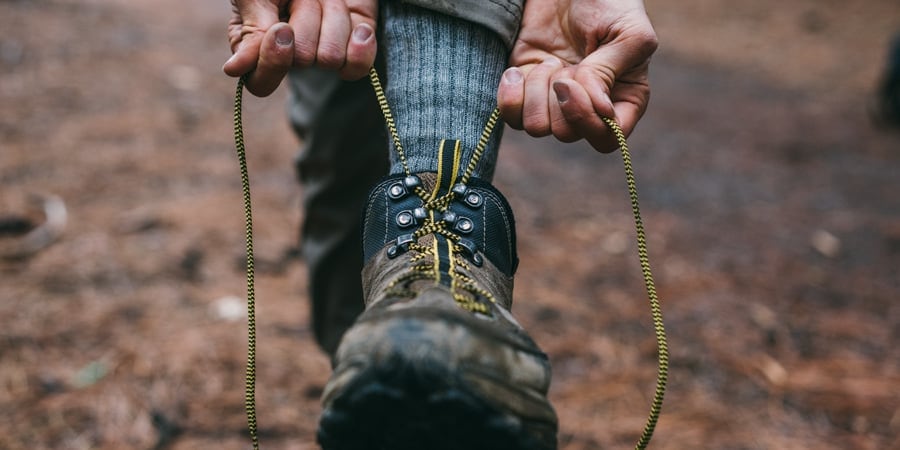
Hiking boots should fit snug everywhere, tight nowhere and offer room to wiggle your toes. Try them on at the end of the day (after feet swell) and with the socks you plan to wear.
Know your size. It's best to have your foot's length, width and arch length measured on a specially calibrated fit device at REI. Foot volume, another key to good fit, must be assessed by a specialist at a store.
You can also measure your foot length and use REI.com sizing charts to find your size. Double-check length later by pulling the insoles out of the boots and standing on them; you should have a thumb's width of space between your longest toe and the end of the insole.
Try on boots at the end of the day. Your feet normally swell a bit during the day's activities and will be at their largest then. This helps you avoid buying boots that are too small.
If you wear orthotics, bring them along. They impact the fit of a boot.
Wear appropriate socks. Familiar socks help you more quickly assess the fit and feel of new footwear. Make sure the thickness of the socks matches what you intend to wear. And on the trail, go with synthetic rather than slow-drying cotton socks, which are more likely to give you blisters. Shop REI's selection of hiking socks.
Spend some time in the boots. Take a stroll through the store. Walk up and down stairs. Find an inclined surface and walk on it.
Fit issues to share with your footwear specialist: You don't want to feel odd bumps or seams, or pinching in the forefoot, nor toes hitting the end of the boot when it's on an incline. If the boots are laced firmly and you still feel space above the top of your foot, then the volume of the boot is wrong.
When shopping online, consider a brand you've worn before. Most boot companies tend to use a consistent foot model over time, so the fit is likely to be similar.
Change your knot strategy: How you lace your boots can change how they fit. See our article on Lacing Tips to improve your fit.
Consider aftermarket insoles (a.k.a. footbeds). Insoles come in models that can enhance comfort, support or fit—or all three. See our Expert Advice article, Insoles: How to Choose.
Break your boots in before your first trip. Too many sore-footed hikers overlook this important step. Read our article Breaking in Your Hiking Boot
to learn how.



